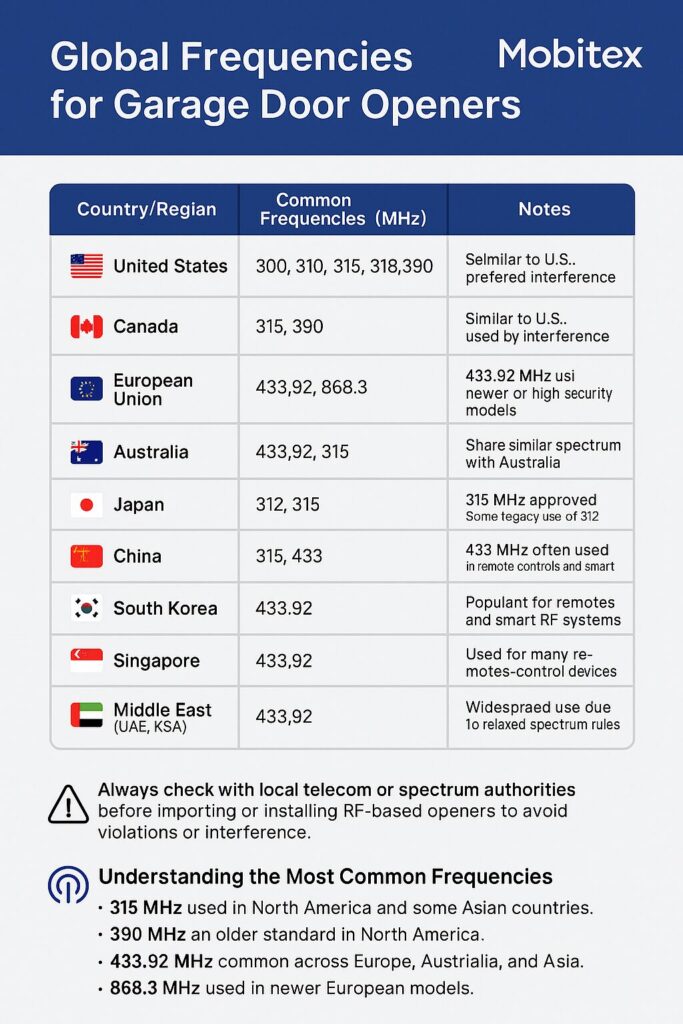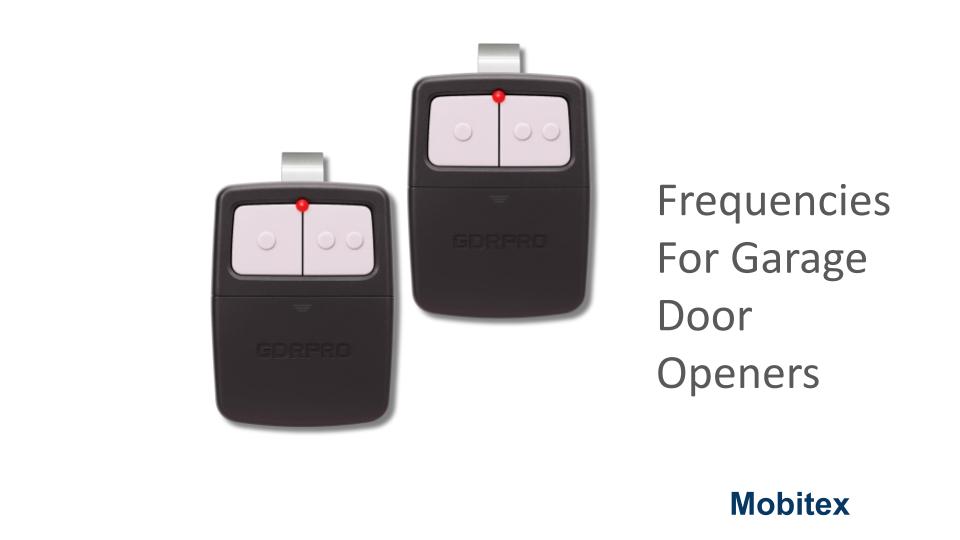Garage door openers rely on radio frequencies to communicate between the remote and the motor unit. These frequencies vary by region due to local regulations and radio spectrum allocations. In this guide, we explore the most common garage door opener frequencies around the world, along with key technical and regulatory considerations.
🌍 Why Garage Door Frequencies Vary Globally
Radio frequency bands are regulated by national governments and regional authorities. To avoid interference with emergency services, mobile phones, or other communications systems, garage door openers must use specific frequencies allocated for short-range devices (SRDs) or industrial, scientific, and medical (ISM) applications.
📶 Common Garage Door Frequencies by Country
| Country/Region | Common Frequencies (MHz) | Notes |
|---|---|---|
| 🇺🇸 United States | 300, 310, 315, 318, 390 | 390 MHz is popular for older systems; 315 MHz is used by newer remotes. |
| 🇨🇦 Canada | 315, 390 | Similar to the U.S.; 315 MHz preferred for reduced interference. |
| 🇪🇺 European Union | 433.92, 868.3 | 433.92 MHz is widespread; 868.3 MHz used in newer or high-security models. |
| 🇬🇧 United Kingdom | 433.92, 868.3 | Matches EU allocations; 868.3 MHz is often used for premium systems. |
| 🇦🇺 Australia | 433.92, 315 | 433.92 MHz is dominant; 315 MHz for some imported openers. |
| 🇳🇿 New Zealand | 433.92, 315 | Shares similar spectrum with Australia. |
| 🇯🇵 Japan | 312, 315 | 315 MHz is approved; some legacy use of 312 MHz. |
| 🇨🇳 China | 315, 433 | 433 MHz often used in remote controls and smart systems. |
| 🇰🇷 South Korea | 433.92 | Popular for remotes and smart RF systems. |
| 🇸🇬 Singapore | 433.92 | Used for many remote-control devices including garage doors. |
| 🌏 Middle East (UAE, KSA) | 433.92 | Widely used due to relaxed spectrum rules for SRDs. |
⚠️ Note: Always check with local telecom or spectrum authorities before importing or installing RF-based openers to avoid violations or interference.

🧠 Understanding the Most Common Frequencies
🔹 315 MHz
- Used in North America and some Asian countries.
- Lower chance of interference with Wi-Fi and Bluetooth.
- Often found in modern systems like LiftMaster, Chamberlain, and Genie.
🔹 390 MHz
- An older standard in North America.
- May still be found in legacy systems.
- Higher interference risk due to shared use by other RF devices.
🔹 433.92 MHz
- Common across Europe, Australia, and Asia.
- ISM band; widely accepted for consumer electronics.
- Compatible with many universal remotes.
🔹 868.3 MHz
- Used in newer European models.
- Offers better range, lower interference.
- Often used in smart and encrypted openers.
🔐 Regulatory Bodies
Here are some of the regulatory organizations that govern RF frequency use:
- 🇺🇸 USA: FCC (Federal Communications Commission)
- 🇨🇦 Canada: ISED (Innovation, Science and Economic Development)
- 🇪🇺 EU: ETSI (European Telecommunications Standards Institute)
- 🇦🇺 Australia: ACMA (Australian Communications and Media Authority)
- 🌍 Global coordination: ITU (International Telecommunication Union)
📡 Interference & Compatibility Issues
Using a garage door opener with an unsupported frequency in your region can result in:
- Limited range or failure to operate
- Interference with emergency or industrial devices
- Legal violations and possible fines
Always choose a frequency that complies with your country’s RF laws.
🧰 Frequency Converters & Solutions
If you’re importing a garage door opener, consider:
- Aftermarket remotes that match your region’s frequency
- Universal receivers that can work across multiple bands
- Frequency converters (rare but sometimes used in commercial settings)
🧾 Summary Table
| Frequency | Region | Use Case |
|---|---|---|
| 300 MHz | USA (legacy) | Early garage door systems |
| 310 MHz | USA | Commercial systems |
| 315 MHz | USA, Canada, Asia | Most modern openers |
| 318 MHz | USA | Some proprietary remotes |
| 390 MHz | USA, Canada | Older models |
| 433.92 MHz | EU, AU, Asia | Common international frequency |
| 868.3 MHz | EU | Smart, secure openers |
🧭 Final Thoughts
When installing or replacing a garage door opener, it’s essential to verify the frequency compatibility with your region. Using the wrong frequency may render your remote useless—or worse, put you at odds with local regulators. Stick to locally approved devices and consider universal solutions when retrofitting or importing.

